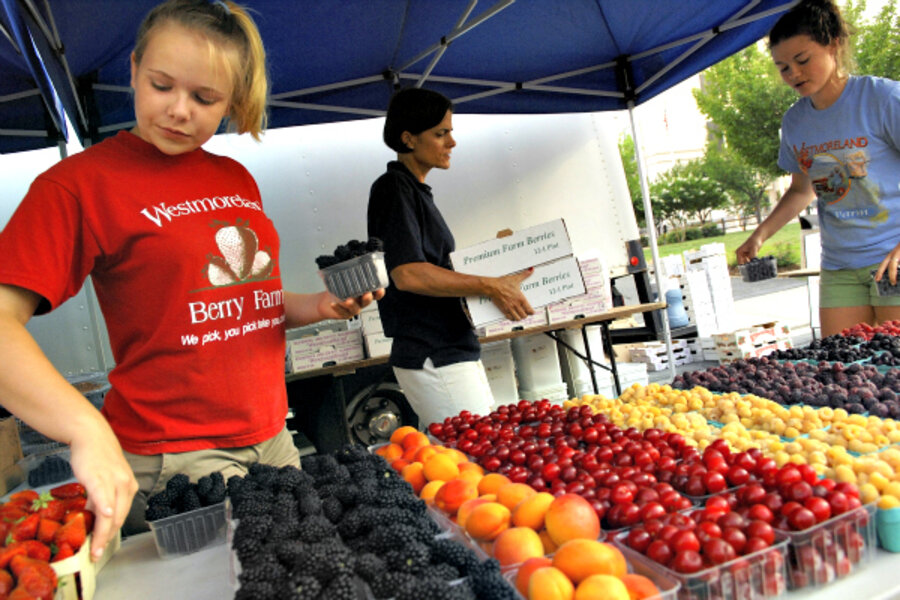Farmers' markets go online
Loading...
It isn’t always easy finding fresh, high-quality food in this country. Supermarkets with their long, complex supply chains usually offer unripe or subpar produce that leaves a lot to be desired.
But the usual alternative methods of provision have distinct limitations. Luckily, technology provides one great answer to this dilemma, opening up an important new avenue for small-scale producers to connect to customers.
Only local farms can deliver the very freshest produce. But while the common methods of providing this bounty to consumers – community supported agriculture (CSA) plans and farmers’ markets – are essential components of a revitalizing fresh-food sector, they don’t always provide a sufficiently flexible or robust shopping experience.
CSAs require a large up-front cash layout and lock you into eating whatever happens to be delivered. Farmers’ markets vary vastly in size and quality, from those that enforce requirements on farm size and distance to those that don’t seem to hold vendors to any standards at all. It’s dismaying to discover resellers at “farmers’” markets; for all you know, they bought their wares at Safeway that morning.
For quality-minded consumers who would like to support local agriculture, it can be a struggle to obtain the freshest food on a consistent basis. And small farmers may struggle to find enough convenient markets for their goods.
But as I discovered in researching my new book on good news in sustainable food, small producers have one magical ace up their sleeve, a tool that could provide a far greater advantage to locally oriented growers than to big nationally focused ones: the Internet. Smart use of the Web can shift the focus of food retail away from industrial suppliers and toward those in the position to offer on-demand delivery of the freshest food around.
I was only able to cover a few choice examples in the pages of my book Change Comes to Dinner, but there are thousands of other innovative efforts where those came from. One example I found particularly inspiring was the Farmers Fresh Market program run by the Foothills Connect Business and Technology Center in Rutherfordton, N.C.
The organization created a proprietary online system to allow individuals and businesses in nearby cities to order fresh produce from growers local to Rutherfordton. In many cases, the growers pick the food the same day the buyers receive it.
In a town where the economy has largely collapsed, the project of connecting local small food-producers with consumers in nearby cities is motivated more by the possibility of job creation than it is by pursuit of culinary nirvana.
“We’re not foodies,” Tim Will, executive director of Foothills Connect and the brains behind the project, told me. “It has very little to do with food and everything to do with jobs.”
This was consistent with another discovery I made while researching the book: The prospect of restoring local economies that have been crippled by changing times or damaging recession is as valid and powerful a reason to invest in local food as many of the arguments one hears about food miles, freshness, and saving the family farm.
In Rutherfordton, Foothills Connect has not only designed a way for city dwellers to support the established farmers of the surrounding rural landscape, but is also helping local non-farmers gain income by becoming growers too.
The organization offers a horticultural training program that teaches would-be small farmers to do raised-bed French intensive organic gardening. Local people with no or little income who are sitting on a wealth of family land can put their inheritance to good use, with the market for their wares provided by Foothills Connect’s Web-based ordering system.
Mr. Will has provided literacy and computer training to those who don’t have the skills to interact with the online system. And the organization has been working hard to ensure that the entire surrounding countryside has the capability for Internet access so no one is shut out.
This great example is but one in a burgeoning universe of efforts that use Web connections to boost the fortunes of small and local producers and help consumers obtain the freshest food. One important trend is the establishment of businesses that distribute the fruits of local farms to individual customers via online ordering systems, like Arganica Farm Club in the mid-Atlantic, Green Bean Delivery in the Midwest, and SPUD in the Northwest. Other services, like Ecotrust’s FoodHub, currently covering the Western US, is specifically geared toward providing food to businesses, restaurants, and other institutions.
And there are scores of others using various different models, each extending a vital lifeline to local growers and helping satisfy the needs of food shoppers who care about the quality and values of their food.
• Katherine Gustafson wrote this article for YES! Magazine, a national, nonprofit media organization that fuses powerful ideas with practical actions for a just and sustainable world. Katherine is a freelance writer and editor based in the Washington, DC, area. Her first book, "Change Comes to Dinner," about sustainable food, will be published in May 2012 by St. Martin's Press.
• This article originally appeared in YES! Magazine.
• Sign up to receive a weekly selection of practical and inspiring Change Agent articles by clicking here.





